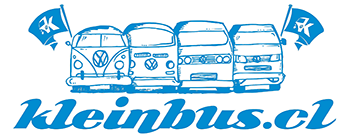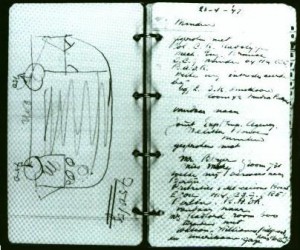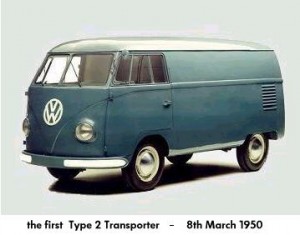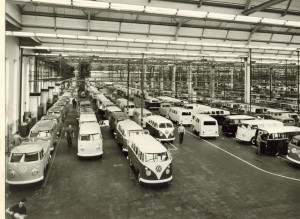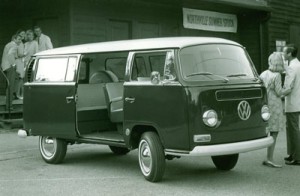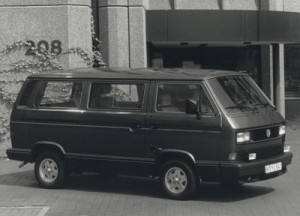Al terminar la Segunda Guerra Mundial, la necesidad de transporte barato fué vital para la reconstrucción de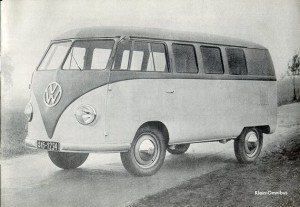 la industria europea, sobretodo la alemana. Bajo este concepto fué revivido el Volkswagen Type 1 ( Beetle o Escarabajo, desarrollado en 1937 ), el cual tuvo un éxito inmediato hasta convertirse en el auto del Siglo XX. En los años cincuenta fué creada con la misma tecnología una variante de transporte de carga o pasajeros: El Type 2, llamado comúnmente Transporter o Kombi
la industria europea, sobretodo la alemana. Bajo este concepto fué revivido el Volkswagen Type 1 ( Beetle o Escarabajo, desarrollado en 1937 ), el cual tuvo un éxito inmediato hasta convertirse en el auto del Siglo XX. En los años cincuenta fué creada con la misma tecnología una variante de transporte de carga o pasajeros: El Type 2, llamado comúnmente Transporter o Kombi
Los primeros modelos de 1950 ( Serie T 1 ) tenían motores de cuatro cilindors boxer de 1200 cc. con una potencia de 25 HP. Desde entonces su potencia ha sido aumentada hasta 1968 cuando surgío la segunda generación de las Combi denominada T2, aunque la T 1 siguió construyendose en Brasil hasta el año de 1975.
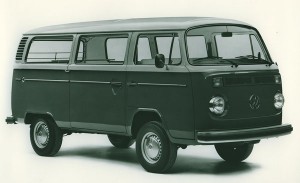 No sólo fue utilizado como carga durante la época hippie en Norteamérica, la Combi fue el vehículo familiar por excelencia, ya que también sirvió como vivienda. Por otro lado, en algunos países de latinoamérica fué utilizada como transporte público y hasta hoy se pueden ver algunos como transpote escolar. El legado cultural que dejó este clásico es grande, valorado más y más con el transcurso de los años.
No sólo fue utilizado como carga durante la época hippie en Norteamérica, la Combi fue el vehículo familiar por excelencia, ya que también sirvió como vivienda. Por otro lado, en algunos países de latinoamérica fué utilizada como transporte público y hasta hoy se pueden ver algunos como transpote escolar. El legado cultural que dejó este clásico es grande, valorado más y más con el transcurso de los años.
Historia con detalles en INGLES
A Brief History Of The Volkswagen Transporter
1947 Ben Pon, a Dutch distributor of Volkswagens, sketches his ideas for the Transporter after seeing VW Beetle-based flatbed trucks used to carry components around the first Volkswagen factory in Wolfsburg.
1948 Pon’s idea for a commercial vehicle is officially accepted by Volkswagen and detailed drawings for a prototype are developed. Many of the components, including the engine, transmission and running gear are borrowed directly from the Beetle.
1949 Testing begins on a prototype Transporter. Unfortunately, because the first prototype is based directly on the Beetle’s frame, it does not have the necessary strength to withstand the stresses produced by the additional weight of the Transporter’s body. After going back to the drawing board, a second prototype using unibody construction is produced. Following successful testing, the Transporter is officially presented to the world in November and production is begun.
1950 The Kombi is introduced. The initial Transporter was intended as purely a delivery type vehicle. While still spartan in appearance, the Kombi offers seating in the rear compartment for passengers, along with windows down the side of the vehicle. The seats are easily removed to facilitate loading of cargo, making it the first combination people/package hauler, hence the name «Kombi».
1951 The Samba Bus (also known as the Micro Bus DeLuxe) is introduced. It is essentially a Kombi bus with all the bells and whistles for passenger comfort included. These include more windows, a sunroof, updated interior, wet bar, surfboard racks, and a good deal of chrome on the exterior.
1952 The pickup version of the Transporter goes into production. Intended for use by construction companies and the like, it has the unique feature of fold-down sides in the bed, enabling the pickup to carry objects larger than itself, provided they don’t weigh very much.
1954 The 100,000th Transporter rolls off the assembly line in Wolfsburg. The engine size is increased, improving horsepower from 25 to 30hp. All models are made available with right-hand drive to increase sales in foreign markets and the postal service.
1955 The first major revisions are made to the Transporter, including an opening tailgate, a full-width dashboard, an overhang above the windshield to accommodate a new ventilation system, and smaller wheels in combination with hydraulic shock absorbers to improve ride.
1956 With the Wolfsburg factory operating at full capacity, production of the Transporter is moved to a new facility in Hanover, which has been designed with production of the Transporter specifically in mind. The facilities include ceiling-mounted cranes which allowed whole vehicles to be moved across the factory with ease, automated painting booths, a large employee lounge with Spaten on tap (after hours), and 24 hour oom-pa-pa music played over the factory PA system.
1958 The pickup version is produced with a double (or crew) cab, as well as the original single cab model.
1959 Two performance improvements are introduced: engine power is increased to 34hp and the transmission features syncromesh on all gears, improving shifting smoothness.
1960 Safety is increased with the introduction of bullet-shaped flashing indicators on the front of the vehicle, replacing the old system of side-mounted semaphore signals, which now seem incredibly dangerous and antiquated, even for the time.
1961 The 1,000,000th Transporter is produced. In addition to being very popular in Germany, it is now driven all over the world, with the exception of the Soviet bloc countries and Texas.
1963 A number of improvements are introduced, including a more powerful 42 horsepower engine, an improved lighting system including larger front turn indicators, a larger rear hatch, the option of sliding side doors, and the increase of payload to one full ton.
1965 Engine is upgraded to an output of 44 horsepower at 4000 rpm. Transporters are still passed on the highway by everything except heavily-laiden ice cream trucks, but with some persistence, they eventually catch up later that night.
1966 One of the major complaints about the Transporter is finally addressed with the 12 volt electrical system replacing the old and inadequate 6 volt system. Transporters can finally operate at night without their headlights dimming at stop signs. Another safety feature – seat belts – are introduced.
1968 The first major revision of the Transporter since its inception. The new second generation Transporter features a revised body shape including a large one-piece front windshield and sliding side doors on all models. Drivetrain changes include a transmission with double-jointed driveshafts and a new 1.6 liter, 47 horsepower engine. The new Transporter is not as esthetically pleasing as the original bus, but it does feature more interior room and hauling capacity.
1969 Two safety-related improvements are introduced – a collapsible steering wheel and stronger doors. A third proposed safety improvement – rocket assisted ejector seats – is rejected due to cost considerations and the existence of overhead power lines.
1970 The engine is redesigned to include dual-port cylinder heads, which improves performance to 50 horsepower at 4000 rpm.
1971 Engine size is increased to 1.7 liters, with a major (well, relatively) power increase to 66 horsepower at 4800 rpm.
1972 The automatic transmission is made available on all models except the pickup. An important safety revision is the redesign of the cab floor with a crumple zone. Drivers are still advised to lift their legs in the event of an impending head-on collision.
1973 The engine is once again enlarged, this time to 1.8 liters, producing 68 hp at 4200 rpm. In a minor appearance change made by the VW Transporter Design Department to justify their existence to upper management, the front turn signal lamps are relocated to either side of the front grill.
1975 The 2 liter engine is introduced, providing 70 horsepower at 4200 rpm. The power increase in turn allows for a new maximum payload of 2500kg. Small engine size finally pays off as owners of large V-8 powered vans are stuck in around-the-block lines at filling stations during the gas crisis while bus owners cruise on by.
1979 The third generation Transporter or ‘Vanagon’ is introduced. This features a complete restyling of both the exterior and interior. Gone are the round shape of the previous two generations of Transporters if favor of a more angular «wedge» shape. The interior is upgraded substantially to include the level of comfort included in modern vehicles. In addition to the body, all other systems are redesigned and improved.
1982 While other Volkswagen vehicles were now water-cooled, the Transporter had hung on to its air-cooled heritage. No longer – the Transporter now features a water-cooled 1.9 liter flat-four engine, also known as a «waterboxer». Also available this year, a 1.6 liter diesel engine (and you thought standard Transporters were slow on acceleration).
1986 The 2.1 liter waterboxer engine is introduced. Highway speeds approaching 100 mph can be attained, but are not recommended.
